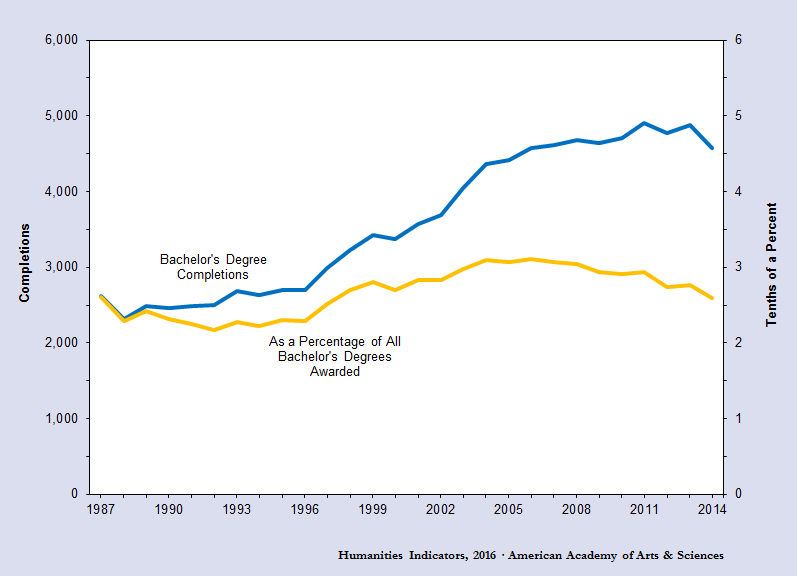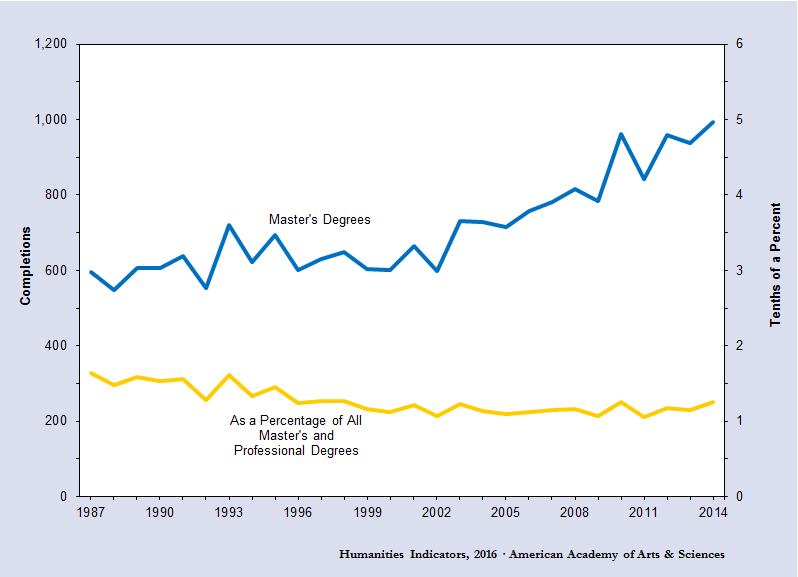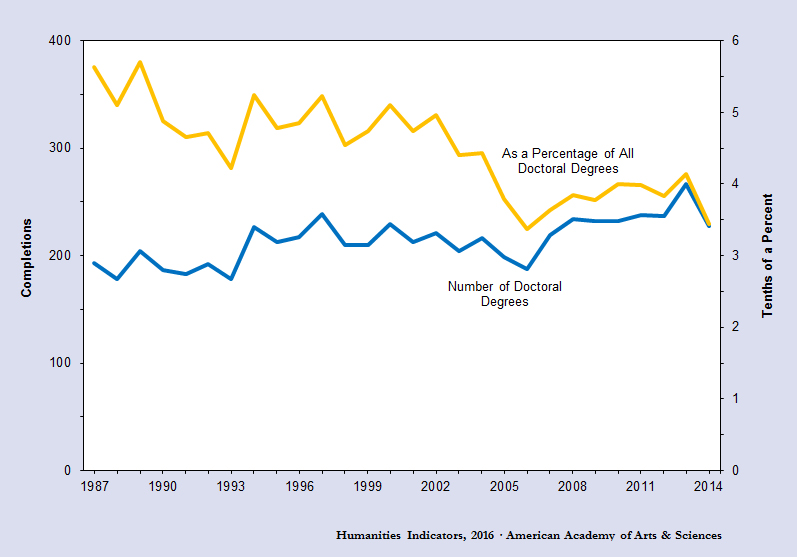Degree Completions in the Academic Study of Religion
- From 2011 to 2014, the number of bachelor’s degrees conferred in the academic study of religion fell 6.8% (from 4,904 to 4,569 degrees; Indicator II-52a). This was the largest decline in 28 years of available data for the discipline. Even after the drop, however, the number of bachelor’s degrees awarded in the discipline was almost 2,000 more than in 1987.
- In 2014, religion constituted 0.26% of the approximately 1.7 million bachelor’s degrees conferred by U.S. institutions of higher learning. This proportion was the lowest point in a downward trajectory that began in 2006, but it was still slightly higher than the levels seen during the dip from 1988 to 1997.
- The academic study of religion conferred its largest number of master’s degrees on record in 2014 (994), an increase of two-thirds over the 1987 level (Indicator II-52b). Despite the growth in numbers, religion’s share of all master’s degrees fell over the same time period (from 0.16% in 1987 to 0.12% in 2014) because of faster growth in the total number of degrees conferred.
- At the doctoral level, the annual number of religion PhDs grew modestly from 1987 to 2014—rising from approximately 175–200 before 1994 to above 225 since 2007 (Indicator II-52c). The highest recorded level, 267, was reported in 2013.
- The growth in the number of doctoral degrees in religion did not keep pace with the general growth in the number of PhDs. The discipline’s share of all doctorates dropped from 0.56% in 1987 to 0.34% in 2014.
II-52a: Bachelor’s Degree Completions in Religion (Absolute Number and as a Percentage of All Bachelor’s Degrees), 1987–2014*

* Degree counts and shares do not include second majors.
Source: U.S. Department of Education, Institute of Education Sciences, National Center for Education Statistics, Integrated Postsecondary Education Data System (IPEDS). The IPEDS data were accessed and analyzed via the National Science Foundation’s online science and engineering resources data system, WebCASPAR.
See the Note on Data Used to Calculate Discipline-Specific Degree Counts and Shares and the Degree Program Code Catalog for an inventory of the specific degree programs included by the Humanities Indicators under the heading of “Religion.”
II-52b: Master’s Degree Completions in Religion (Absolute Number and as a Percentage of All Master’s and Professional Degrees), 1987–2014

Source: U.S. Department of Education, Institute of Education Sciences, National Center for Education Statistics, Integrated Postsecondary Education Data System (IPEDS). The IPEDS data were accessed and analyzed via the National Science Foundation’s online science and engineering resources data system, WebCASPAR.
See the Note on Data Used to Calculate Discipline-Specific Degree Counts and Shares, the Note on the Definition of Advanced Degrees, and the Degree Program Code Catalog for an inventory of the specific degree programs included by the Humanities Indicators under the heading of “Religion.”
II-52c: Doctoral Degree Completions in Religion (Absolute Number and as a Percentage of All Doctorates), 1987–2014

Source: U.S. Department of Education, Institute of Education Sciences, National Center for Education Statistics, Integrated Postsecondary Education Data System (IPEDS). The IPEDS data were accessed and analyzed via the National Science Foundation’s online science and engineering resources data system, WebCASPAR.
See the Note on Data Used to Calculate Discipline-Specific Degree Counts and Shares, the Note on the Definition of Advanced Degrees, and the Degree Program Code Catalog for an inventory of the specific degree programs included by the Humanities Indicators under the heading of “Religion.”

